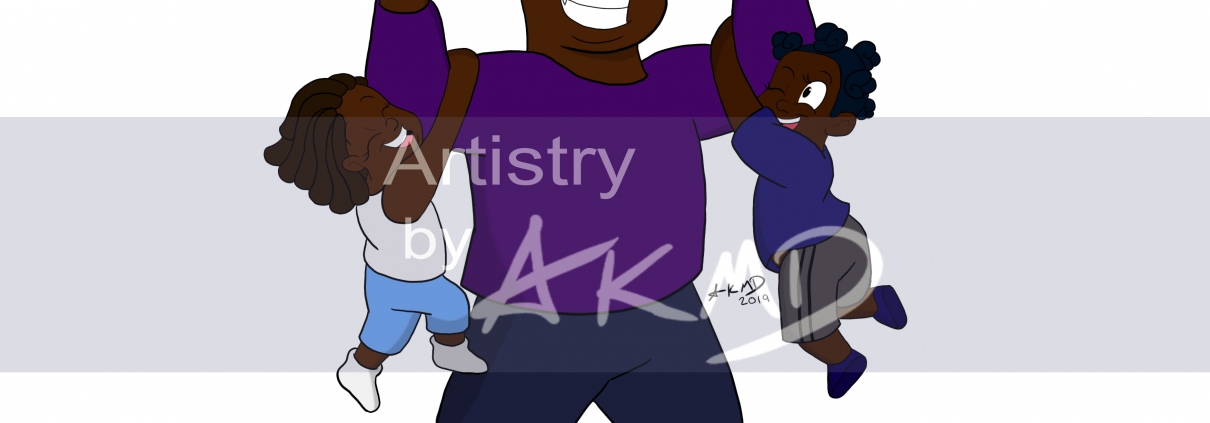Autism Awareness Week Interview by Lauren McLane with Ash Jeffrey-Taylor
This year, March 28 to April 3 is World Autism Acceptance Week, which highlights and promotes topics around autism awareness. Ash Jeffrey-Taylor is a creative artist and activist who raises awareness about autism through her own stories. Recently, I had the opportunity to speak with Ash over the phone about her artwork, creative expression, and why she’s advocating for women and girls this Autism Awareness Week.
Currently, Ash creates commissions, comics, and drawings that often reflect her life experiences and identities. I asked Ash about when she began this journey as a creative. Please note, some of the transcripts have been edited for accuracy and precision.
A: To start off, I’ve been drawing since I was very, very young. And I didn’t take it seriously until my teens, once I hit secondary school.
L: Nice. Why do you think you started to take it a little more seriously or consider it as a career?
A: Well, at first, it felt like a hobby to me, and once I hit my late teens in college, I thought, “I think this should be my calling”. So I’ve been improving, experimenting with different art styles, and hand-picking which style I like the best to adapt as my own.
L: No totally, and it totally comes through in your work. I notice that you draw a lot of people which is cool, and a lot of your own identities…
A: Yup.
L: What do you think art does for you – I know that for me it can be relaxing or a way to express myself – do you feel like that’s the same?
A: Yeah, it’s mostly to express my true self when I can’t talk properly (laughs).
L: Yeah, that’s cool. I also noticed [you draw] either personas or a lot of families, and I know you’re a black artist –
A: Yeah!
L: – with autism, and I was wondering: how do you think that’s shown in the work you like to make? How does your identity come into it, you think?
A: Well, it’s very useful to express my true self when I want to be honest with myself, or want to brighten up people’s day with what I’ve been through. Or, share my uncomfortable experiences and what’s happened to me in the most humorous way possible.
L: Definitely. Do you find that people relate to the things you put out?
A: Maybe a handful, yeah.
Ash chuckles modestly. I think it’s really cool that a lot of her artwork is about self-expression, and because some of her art outlines her own experiences, I can’t help but think that others, perhaps women with similar experiences, might relate to it, too. Boys are four times more likely than girls to be diagnosed with autism, and Ash brings this to attention in her discussion and artwork. She spoke about her own experiences being diagnosed with autism relatively early – but still not until young adulthood – and how certain factors like gender may play a part.
L: I noticed on your Instagram that you mentioned you like to advocate for autism in women and girls specifically, and I was wondering where this comes from. Why is this an issue you’re passionate about?
A: Well, growing up, I had no idea that I’m autistic, since… I was diagnosed at a young age, which I’m grateful for. But I didn’t know that I’m actually austic until I was eighteen years old.
L: Oh wow.
A: Yeah, it’s kinda … in other words, I was kinda clueless about what made me different until I hit the later age.
L: Do you think it’s harder for women and girls in general to be diagnosed than boys?
A: Yeah, I think it’s just a little unfair, because people assume autistic girls are just attention seekers or attention deficit or dyslexic or whatever, but I feel like some parents with autistic girls don’t find the right professionals who are respectful and smart enough to do a proper diagnosis instead of just misdiagnosing them as something else.
L: What do you think some things that could be done to improve that are?
A: I say more research for children of mixed genders – not just little boys but mixed up with the girls as well, so they could pin down the main traits and specific discomforts autistic children are experiencing, so they won’t delay the diagnosis for all the older women, who may get diagnosed later in life.”
We discussed Autism Awareness Week coming up, and how Ash is bringing these issues to light for the week. She noted, “I think it’s just sharing my life experiences on the spectrum, or things that happened to me, or things that’s been said about girls on the spectrum – either positive or extremely messed up. So I have quite a few ideas. I’ve wanted to make my original story off it, and so far I’m in the middle of developing one story that I’d like to create someday.”
Her artwork, which is a combination of both hand-drawn and digital art, does just this. Ash is currently freelancing, which includes illustrating greeting cards, posting online, and creating commissions, from which she’s saving to start her own business. I asked if generally, there’s anything she wished more people understood about creatives, and particularly those with autism.
A: Well, what I want personally is people who don’t just view autistic people as someone who is either immature in specific areas, or just like blunt or plain rude. We just see the world differently – some are expressive and loud, while others are just reserved and quiet. I’m kinda in the middle, depending on my mood. All I want for people is just… to get a basic understanding, not just for children on the spectrum, but adults on the spectrum, because it’s a lifelong condition – it’s not a condition that just disappears after childhood.”
L: You mentioned being able to see the world kind of in a different way or differently… Do you think the perspective that you have has kind of allowed you to be more creative or to be pursuing art in the way you want to?
A: Yeah, I do. I just find all kinds of creative arts really satisfying, whether it’s tailored to children of all ages or adults who just want a good escape.
We spoke about all the adults that escape and take refuge in the Tate Britain art gallery, where Ash currently volunteers and works as a visitor host. In terms of moving forward with her art, she notes that “that’s a good way to increase my art knowledge and passion there.”
The pandemic delivered a massive blow to museums and galleries, but Ash says that they’re somewhat bounding back, and is optimistic for the future. She told me how “It’s nice to see people from all different walks of life – even those who are not from the UK. It’s nice to see visitors from other countries who just come to see a large but quiet gallery – just to see a specific artist or an artwork.
L: Do people really come from other countries just to see some of the work?
A: Yeah, honestly – some from the East Asian regions, some from France, parts of Europe, even America, so yeah!
I asked if there’s anything else she wanted to talk about, either with regards to the arts or autism awareness in general. She’s in the process of creating “a small comic for autism awareness/acceptance week that I’m planning to upload on Instagram soon.” It has to do with how most people react when Ash mentions her autism, which she says is often along the lines of “‘You’re autistic? But you don’t look it!’ That’s kinda harsh”, she says. “The thing is, I look like an average person, but I’m actually autistic. And I’ve learned why I look like an average person – it’s because of all the masking I’ve been doing! It all makes sense. That explains why I stress myself to the point of fitting in. It’s kind of exhausting.
L: Yeah, that sounds tiring! And I don’t think I’ve actually heard that term before – if you don’t mind me asking, what is masking?
A: You know when someone puts on a happy face to hide the fact that they’re depressed or in pain?
L: Ah, okay.
A: It’s basically that.
L: And you feel like you do that a lot of the time?
A: I do. I do. I didn’t know I’ve been actually doing it until someone explained it to me about a year ago, and I thought, ‘No way, that’s what I’ve been doing all this time?’
L: That sounds exhausting, really tiring. That’s intense! Do you feel like art is a way to deal with that a bit?
A: I feel like some artists had to go around masking their true feelings, or until they make a drawing out of it – whether it’s something that happened to them recently or something just to please their commissioners.
Ash told me it’s “nice to draw by hand”, and I understand how doing so can be both a means of self-expression and self-care at the same time. When it comes to the functions of art, issues around autism awareness and identity, and self-expression, Ash is deeply reflective, and clearly the person in-the-know. I learned much more about ways to address autism awareness issues in talking with Ash, and I look forward to continuing to learn more through her future artwork and projects.
You can find Ash’s work on Instagram Ash (@artistrybyakmd), her website, https://ashjeftay91.wixsite.com/akmdportfolio, and her Youtube channel at Artistry by AKMD.
By Lauren McLane





